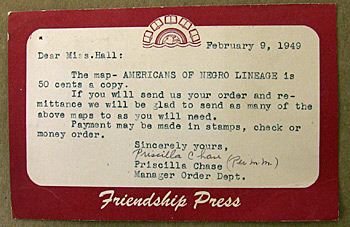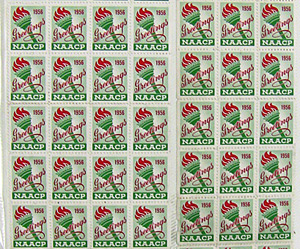At an auction recently, I bought a box of ephemera listed as mid-20th century African American items. The lot was among several containing African-American history-related papers and documents, and I checked out each of them.
Black history items show up from time to time at auction, not just in February during Black History Month. Sometimes, the history is obvious as in the items in this special sale that included other types of ephemera – from movie posters to song books to photographs to signed letters to car brochures.

Even the most mundane of items sometimes hide the hands and genius of African Americans, such as the woman who improved on the wringer washing machine or the man who built cars at the turn of the 20th century or the first black magician in this country.
I learned about these people through items for sale on the auction table. And that’s how black history should be learned and shared – in context with American history because they both happened in tandem. I’m sure that Carter G. Woodson didn’t expect his creation of Black History Week in 1926 (it became a month 50 years later) to become the norm.

African Americans made history day after day and month after month and year after year. The artifacts from that history span years and generations, and encompass a plethora of subjects ranging from music to politics to employment to books. The box lot of papers at auction attest to that – even though the documents cover only a snippet of history, from more than 50 years ago.
The items apparently came from the estate of Mazie B. Hall, a teacher and civil rights activist who lived in the Philadelphia suburbs, because her name was on one of them. Her important papers are in the Charles L. Blockson Afro-American Collection at Temple University.
Here’s what was in the lot:

Constitution & By-Laws of National Association of Negro Business and Professional Women’s Clubs
When African Americans were forbidden from joining white organizations, they resourcefully founded their own. The National Association of Negro Business and Professional Women’s Clubs Inc. was formed in the 1930s (this amended set of bylaws was circa 1970).
There was a paucity of African American businesswomen during the time, according to the association’s website. The national grew out of an idea in 1934 by New York realtor Emma Odessa Young, a member of the New York Club of Business and Professional Women, to pull their few numbers together. An invalid, she was not able to lead this endeavor and handed it off to Ollie Chinn Porter, president of the New York club. Other such groups were invited to join, and the founding members included women from New York, Philadelphia and Atlantic City.
The first convention was held at a Methodist church in Atlantic City in 1936. One of the aims of this new organization was to encourage and develop opportunities for black women in businesses and the professions.

“Amos ‘N’ Andy” special feature in the Voice of the Air newspaper, 1930
The “Amos ‘N’ Andy” show was more a misrepresentation of African Americans rather a realistic portrait of them and their lives. The language was illiterate, the characterization infantile, and the blackface insulting.
Freeman F. Gosden (Amos) and Charles J. Correll (Andy) were two white men posing in blackface on one of the most popular radio shows of the 1920s and 1930s. Filled with racial stereotypes, the show found an audience among both white and black listeners. It also ignited protests from some black organizations.
The show took place at a taxi cab company in Harlem owned by Amos and Andy, with each of them playing different roles as African Americans. The show was first broadcast on radio starting in 1928 and ended on TV in the 1950s, by then with black actors, including a character named Kingfish.
“The touchingly human and intensely humorous experiences of Amos ‘n’ Andy, cherished in every corner of the broad country, bring pleasure to millions, and Correll and Gosden are among the highest paid radio entertainers. Such is the romance of radio.” The two had just signed a contract to make a talkie, which with royalties was expected to net them a million dollars, according to the newspaper.
Not everyone was enamored with it. It was criticized by some African American organizations right up until it went off the air in the 1950s.

“The Negro in the Postwar World” speech by U.S. Rep. Adam Clayton Powell Jr.
The lot contained an envelope and copy of a speech submitted by Congressman Adam Clayton Powell Jr. of New York on June 28, 1945, into the record of the U.S. House of Representatives. Powell had made the speech three days earlier at the annual Negro Freedom rally at Madison Square Garden. The rallies were held from 1943 to 1945, and Powell was among the organizers. The 1945 rally drew 20,000 people.
“We, the Negro people, continue to take our historic stand for right, for truth, for justice, for equality – not at some vaguely promised date with destiny – but now, right now, in this immediate present. We will not compromise, we refuse to be neutral, and we are not going to mark time.”
“Before the war in Europe came to an end, by order of the President of the United States, Negro men fought side by side with whites in the same regiments. The Air Corps was opened up to brown men. Black men covered themselves with glory in the uniforms of the Marine Corps at Tarawa and Bougainville. … Our women today are marching in the WAVES and the SPARS, and serving in the United States Nursing Corps.
“On the home front, black hands of skilled men and women machinists work side by side with their white comrades on the machines of production. Great ships today are sailing the seven seas proudly bearing the names of Negro patriots – Booker T. Washington, Frederick Douglass, Sojourner Truth, Robert L. Vann. … So I repeat tonight, there can be no compromise, there can be no marking time. Our cry tonight is ‘Carry on; forward!'”
Those ships he mentioned were news to me. I found that during World War II, the military made 17 Liberty ships bearing the names of African Americans. I could not find a ship named for Sojourner Truth.

Postcard regarding the map “Americans of Negro Lineage”
This 1949 postcard was addressed to Mazie B. Hall asking her to send 50 cents with her order for a copy of “Americans of Negro Lineage.” Published in 1946, the map – illustrated by Louise E. Jefferson – showed contributions of African Americans, historical sites, birthplaces of noted African Americans, earliest arrival of Africans as slaves as well as the various occupations of African American women.
Unfortunately, the box lot did not contain a copy of the map itself. Swann Auction Galleries in New York sold a copy last year for $900. The map was updated and reprinted in 1965.

“RCA Baton” newsletter
This 1959 newsletter contained photographs and news of RCA’s African American employees, as well as a short article about Lena Horne signing a recording contract with RCA Victor and a photo of Ella Fitzgerald rehearsing for a spot on the Milton Berle show. The newsletter was published by the Joseph V. Baker public relations firm in Philadelphia.
Baker was hired by NBC – whose parent company was RCA – in 1950 to be its eyes and ears in the black community. At the time, CBS had a better relationship with the community and NBC figured that to remain competitive, it had to clean up its act. Baker was already under contract with RCA.
The “RCA Baton” published articles about African American employees and their accomplishments, NBC programs pertaining to or of interest to blacks, and items and products aimed at consumers.
The most interesting thing I found in the auction issue were the photographs of African Americans as a station floor manager and engineers (most were men), an assembly worker, typist and middle-class women viewing a “Whirlpool Miracle Kitchen” at the Chicago Defender’s 25th annual Home Service Exposition – which apparently was held during the 1950s and 1960s by this African American newspaper.
“Hello Dolly” program with Pearl Bailey and Cab Calloway & Lena Horne photograph
Both of these items showed African Americans’ contribution to theater and the movies. The all-black “Hello Dolly” musical played Broadway in 1967 with Pearl Bailey and Cab Calloway before sold-out audiences. Bailey won a Tony Award in 1968, and here’s her performing at the ceremony (she appears at 3:44 into the show).
What can I say about Lena Horne: She was the best, and so was Cab Calloway.

NAACP Christmas Seals stamps
The NAACP raised money by selling Christmas Seals starting in 1927, and the box lot contained a page of stamps from 1956. Louise E. Jefferson illustrated the stamps for 30 to 40 years. I wrote a blog post about the stamps last week.
